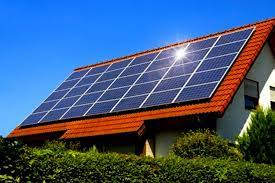Solar-Rooftop Calculator | Calculate Daily Unit Consumption & More
Articles, products, and services offered on this site are for informational purposes only. We are part of the Amazon Services LLC Associates Program, an affiliate advertising program. Amazon.com is compensated for sales resulting from links on our website.
Please review our disclaimer before acting based on anything you read or see.
A growing number of people are turning to solar energy to generate electricity. It is one of the finest strategies to lower your carbon footprint and increase the effectiveness of your house. However, before you go and invest, it’s crucial that you fully understand what you’re getting into. This is where a solar rooftop calculator comes in useful.
Electricity is produced by solar energy, an endless supply of energy. Based on the solar system type, we may either store the extra energy produced or feed it into the electrical grid in exchange for energy credits.
The fundamental idea behind how solar energy is transformed into electricity holds for all systems. A solar cell is fundamental for turning light energy into electrical energy. A solar panel generates electricity when a light beam impacts its surface and ejects electrons. You’ll find the Solar-Rooftop Calculator to be of tremendous use. Come along as we highlight more on this below.
What is Solar-Rooftop?
Solar rooftops are solar panels installed on the roofs of buildings that are either commercial, governmental, or residential. These panels convert solar energy from the sun’s light into electrical energy. A different name for this configuration is Solar Rooftop Photo-Voltaic System.
It generates a clean, environmentally friendly kind of energy, which means it is an energy source that doesn’t generate any pollution or dangerous gases. Solar panel systems do not harm animals or people.
A photovoltaic system known as Solar-Rooftop also has its electricity-producing solar panels positioned on the roof of a home or other building or structure. Photovoltaic modules, linear systems, cables, solar processors, and other electrical accessories are some of the system’s many parts.
Compared to ground-based photovoltaic power plants with a capacity in the megawatt range, rooftop installed systems are modest. Residential structures often have rooftop P.V. systems with a capacity of between 5 and 20 kilowatts (kW). While those that are put on business structures often have 100 kilowatts or more.
How to Use Solar-Rooftop Calculator
Using an interactive map and a free application, a solar-rooftop calculator will help you determine how much solar electricity your rooftop might produce. It is simple to use. Input your roof’s square footage and click “Calculate.” After that, the program will estimate the amount of electricity your roof-mounted solar panels produce.
You may use a solar rooftop calculator to estimate how much power your house can generate and the number of solar panels you’ll need for the system to be financially viable. Additionally, depending on your current consumption habits, it will offer you an approximation of the monthly energy cost savings you might anticipate. A solar power calculator may also help you determine whether solar electricity is practical for your property.
Solar-Rooftop Calculator
Types of Solar-Rooftops
Some Types of Solar-Rooftops include:

On-Grid System
A solar panel, solar inverters or micro converter, a meter, and the grid make up an on-grid system. The solar panels produce D.C. power when they are exposed to sunlight. Since most of our household appliances operate on A.C., solar energy must be transformed into A.C. energy using an inverter before it can be used.
We get the energy to power our devices via an electric meter, which receives the A.C. electricity supplied by an inverter. The excess solar energy produced is exported to the grid and is eligible for payment through energy export credits.
The grid may provide energy throughout the day or when the solar power system is not producing.
The On-Grid technology is appropriate for areas with few or no power disruptions. We cannot store power for emergency backup since this system’s battery is not employed.
Off-Grid System
A stand-alone power system is another name for an off-Grid system. Instead of being wired into the power grid, it is linked to the battery. Solar panels, a battery, a charge controller to manage battery charging and avoid overcharging, and an inverter are all components of this system.
Solar panels provide D.C. energy, which is sent into a charge controller, which then uses the regulated voltage to charge a battery that drives an inverter. The inverter converts D.C. into A.C. so that it can power the appliances.
The battery’s accumulated energy may be utilized at night and during power interruptions. For isolated places without an energy grid, the Off-Grid System is appropriate. This technique is pricey, however, since batteries are so costly.
Hybrid System
A hybrid system combines the grid with batteries. It comprises solar panels, a grid, a voltage regulator, a battery, and an inverter. After being used by appliances, the excess energy generated by the solar system in this system is transferred to the battery bank. They may export the additional energy to the grid after fully charging.
This system combines on-grid and off-grid components. The surplus energy produced throughout the day will be kept in off-grid batteries. If excess energy is saved, it is similarly supplied into the grid as an on-grid.
Batteries may serve as an emergency backup during blackouts or at night. If there is no solar power and the battery is already exhausted, it is possible to draw electricity from the grid while concurrently charging the battery.
Things to Consider before Calculating the Solar Rooftop
Some Things to Consider before calculating the solar rooftop include:

Content
Solar panel installation may be done with most roofing materials without causing any damage to the roof. It looks beautiful with composite or asphalt shingles, and installation is straightforward. Solar panels work well with metal roofs and are simple and affordable to install. Having stated that, the information above does not cover wood and slate roofs.
Angle and Pitch
It would help if you positioned your solar panels to maximize their efficiency to get the most sunlight possible. On average, the panels must be angled to get the best sunlight.
Permanent, roof-mounted solar energy equipment should ideally be built at an angle corresponding to the area’s latitude. In most circumstances, pitch angles around 30 and 45 degrees are effective.
Form and Dimension
The size and form of your roof are two more characteristics that affect its viability for solar panels. A big, square roof is the ideal form and size for panels.
Roof Alignment
Solar panels and calculations work well when mounted on rooftops with a southern orientation. On the other hand, panels that face southwest or southeast might still be useful. You may also request that the installation contractor use a rack to change the orientation.
Shade
The most frequent causes of shadow include neighboring trees, clouds, solar panels, rooftops, and buildings. It’s a common misperception that contemporary solar panels function even in dim light. But this is untrue.
Solar panels work on overcast days and dark locations, but their output is reduced. Solar cells that can withstand shade, like Uni-Solar, may reduce efficiency losses.
Frequently Asked Questions
How many units does a 1kw solar panel produce?
A 1-kW solar panel will provide around 4 kWh of power per day on a typical sunny day. We may thus estimate that a solar panel generates about 133 units of power each day, 40 units per month, or 480 units yearly.
How many solar panels do I need for my roof calculator?
Split your average hourly wattage demand by the number of peak sunshine hours per day in your location to obtain an estimate. This tells you how much energy your panels must generate each hour. The typical U.S. residence (900 kWh/month) would need 6,000 watts in a region with five peak solar hours per day.
How many kW solars do I need?
You may calculate the required renewable generation kilowatts by dividing your yearly kWh use by 1,200. Therefore, if the total energy used throughout your past 12 utility bills is 24,000 kWh, you will need a 20-kW system (24,000 / 1,200 = 20).
Is 1 kW enough to run a house?
According to solar power system specialists, one kilowatt (kW) of solar electricity is sufficient for an average household of three to four people. But a larger household or the need to operate an air conditioner at home will need two to five-kilowatt solar panels.
Can I run a 1.5-ton A.C. on solar without batteries?
In conclusion, a 1.5-ton air conditioner can run without a battery. However, you must first carefully assess your energy needs to see if your solar panels can provide them.
Why are solar panels not worth it?
Since solar panels cannot store energy, their production will be reduced under cloudy conditions and will be nil at night. As a result, solar batteries are necessary for the majority of household solar systems.
Is 3kW solar enough?
In a modest house with two to three people, a 3kW system of solar panels may power the majority of the appliances.
It can generate up to 2500kWh annually, which should be sufficient to power all the normal appliances in a house with two bedrooms and one bathroom.
Is a 4kW solar system worth it?
A family of three or four may have their energy demands met by a 4kW solar panel installation. By installing such a system, you may reduce your power costs while simultaneously improving the atmosphere in your house. Due to the product’s extended lifespan and minimal maintenance needs, it will also simplify your life.
Expert Opinion
Solar rooftop shingles are one of the newest solar panel solutions that are becoming more and more well-liked as a means to test the waters of energy efficiency.
A contemporary solution to having a stunning roof that may resemble asphalt shingles and run a solar energy system is to use solar rooftop shingles.
Solar roof shingles provide the same level of roof and property protection as traditional asphalt shingles in terms of durability. Each placed solar shingle may produce solar energy in the range of 13 to 67 watts. Additionally, they can survive almost all-weather conditions.
They appeal to homeowners because they are aesthetically pleasing and simple to integrate. Homeowners may measure their effectiveness and output with solar shingles since they often have software and smartphone connections. At this point, the Solar-Rooftop Calculator will aid you immensely.



Comments are closed.